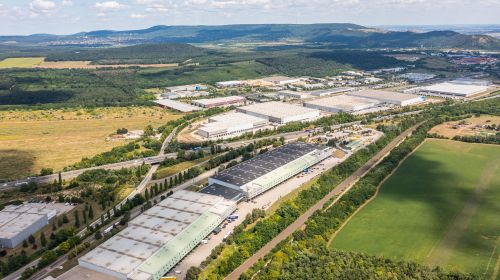The European Union Property Review
Europe's capital city
Brussels holds 12 million sqm of office space, around 1.2 million sqm of which are looking for tenants - vacant space amounting to around 9.92 percent. Rented space in 2003 was 700,000 sqm, the third best performance in the city's history. Indeed, no other European city could compete with the Belgium capital in this regard, which is hardly surprising when you bear in mind that European Union institutions took up 100,000 sqm with other international institutions occupying a further 50,000 sqm. Rents in Brussels have been rising since 1997, climbing to around 23 euros/sqm in September last year. The annual total renting cost per sqm was 422 euros, which places Brussels 15th in the world. But the Belgian capital stands second as regards the location with the most rapidly rising rents. Investment transactions on the office market absorbed around 2 billion euros, almost 90 percent of which concerned three districts of Brussels. Only so-called opportunistic investors purchased properties in other locations. There were 258 transactions registered last year on the Belgian real estate market (totalling 95,000 sqm) of which 197 (56,000 sqm) concerned renting of space on shopping streets and 61 (38,000 sqm) in shopping centres. Rents have remained stable throughout the whole country for at least 1.5 years. The highest rents in Brussels and Antwerp amount to some 100 euro/sqm. The rate of return on investments is around 6 percent.
The French are a wary lot
Commercial property rents have started to stabilise, while the return rate in investment transactions remains steady. Companies wish to save and are discovering that is possible by managing their property folios more efficiently. Rents exerted the greatest impact on demand in the retail sector, which were not steered by the desire to maintain high profitability. Rents stabilised throughout the whole sector, apart from spaces between 500 and 2,500 sqm, and also in less attractive locations where a slump was recorded. The spaces offered on Parisian shopping streets usually do not exceed 5,000 sqm, whereas they frequently reach 8 to 10 thousand sqm in other large cities. Rents amount to between 170 and 700 euro/sqm on the largest Paris shopping streets. Space available in French shopping centres increased by 235,000 sqm last year. Plans covering the oncoming 7 years envisage the commissioning of more than 2.5 million sqm, 200,000 sqm of which are already under construction, while a further 410,000 sqm have already been granted imperative permits. Provincial shopping centre rents vary between 60 and 100 euro/sqm, and reach even as much as 150 euro/sqm in Paris. Last year saw almost 1.6 million sqm office space leased in the Paris region (546,000 sqm in Paris alone), which amounts to a 9 percent increase. Rental transactions above 5,000 sqm accounted for 47 percent of the total space. Vacancies amounted to 6.9 percent, around 5 percent in Paris alone. Almost 2 million sqm were offered for renting at the end of 2003, to enter the market in the course of 12 months. An additional million sqm are to be placed on the market in 2005-2006. The total value of investment transactions reached 9.8 billion euros in 2003, a 13 percent fall compared with the previous year. This market weakness stemmed from a lack of good quality investment products, which was the outcome - in turn - of uncertainty concerning rents in the office and industrial sectors.
Retail? Oh, yes!
While the value of the French investment market may make an impression in Poland, the situation makes a very poor impression on the other side of the English Channel. Investment transactions on the British market reached a ceiling of 12 billion euros (8 billion pounds) in the fourth quarter of 2003 alone. Over the whole year, real estate worth as much as 40 billion euros (27 billion pounds) changed hands. The greatest causes for landlord satisfaction were given by retail properties (35 percent of all investments), which generated returns of around 16 percent last year. The large demand for new shopping space, particularly in city centres, meant that new projects of a total 880,000 sqm were rented off hand. The Birmingham Bullring, the largest shopping centre commissioned last year was 90 percent pre-let. Shopping space developers are particularly pleased with the amended regulations presently being introduced, which make it easier to construct and enlarge objects on city outskirts. The trading sector might face considerable turbulence in 2004 when 25-year rental contracts expire in the largest British discount shopping centres. Properties in better localities will surely be enlarged while those in worse localities surely await painful times. Office building landlords had reasons for disquiet, since their properties bring them an average return of only 3.4 percent. Around 2 million sqm new space appeared in Greater London (250,000 sqm in the City, 240,000 in the West End), of which around 1 million have been let. Rents in the best localities were tangibly the highest in Europe, amounting to around 60 euro/sqm in the City and 77 euro/sqm in the West End.
Subletting
The principal feature of the Dutch office market is high, supply partly caused by tenants subletting the space they occupy. Developers do not construct new buildings without earlier signing leasing contracts. Only 58,000 sqm appeared last year, which increased the total supply to 1,218,000 sqm (of which 700,000 sqm are available "on the spot"). In 2001 more than 400,000 sqm were let, while last year the space was a bare 241,000 sqm, vacant space climbing to almost 16 percent. The consequence of this small demand is that the office market has become a tenant's market. Developers are having to fight for customers by offering abatements and various facilities. Some contracts are concluded at very low values. Rents have not yet dropped in the best locality in the country, that is in the southern districts of Amsterdam. Calling rents dropped by an average 1.4 percent in 2003 and stabilised at almost 16 euro/sqm.
Unhurried waltz
In 2003 Vienna offices offered 9.6 million sqm space, with last year's rise in supply being identical with that of 2002 and amounting to 300,000 sqm. Analysts expect 300,000 sqm new office space this year as well, especially since the amount of rented space has regularly increased in the past two years. Tenants occupied 150,000 sqm of offices in 2002 and 200,000 sqm a year later. Forecasts predict that this year will see 250,000 sqm finding new tenants. But 320,000 sqm were let in the record year 2000, when only 2.6 percent was left vacant. Since supply continues to outstrip demand, the percentage of vacancies will rise to 6.7 this year. Last year rents eased slightly, the highest demanded today being 20 euro/sqm in the city's best locations. As much as 22 euro/sqm has to be paid for de luxe offices and the highest storeys in high-rise buildings. Space is available in new buildings in worse localities for 9-11 euro/sqm. It is no easy matter finding space to rent in highly attractive locations on the commercial market. The space available is negligible and prices are unusually high. On the other hand, whole streets, once treated as commercially attractive, are vanishing from city business maps. 100 largest Austrian shopping centres have a total retail space of around 1.6 million sqm, the largest scheme in the country - Shopping City Sued (136,000 sqm) being almost twice the size of the largest Vienna centre - Donauzentrum (77,000 sqm). Rent in Austria's most expensive locations (4 in Vienna, 13 in other cities) amounts to as much as 360 euro/sqm, though "only" 15 to 18 euros are asked for in good locations in Vienna shopping streets. In normal shopping centres rents amount to between 18 and 25 euros. Investment contracts were concluded in Austria last year for a total 1.3 billion euros, that is 400 million euros more than two years ago. Investors - largely German investment funds - are only interested in properties at least 70 percent let.
Renting, Hungarian style
Though Budapest acquired 83,000 sqm new office space in 2003 and the amount of modern space increased to 1.36 million sqm, the pace at which it was being rented continued to rise. The result was that around 138,000 sqm found new tenants, vacant space dropping to 20.5 percent. That continues high which is why tenants operating on the Budapest market enjoy low rents of about 16.5 euro/sqm in the best city locations. Around 75,000 sqm office space should appear this year, with demand staying at last year's level. Work is presently proceeding on buildings which will bring 120,000 sqm to the market in 2005. The Hungarian investment market is arousing substantial interest and requirements among investors and also is displaying a lack of good investment products for sale. Capitalisation rates in the best sites are 8.5 percent for offices, 9.0 percent for shopping centres and around 9.75 percent for industrial objects. Analysts suggest these rates will remain steady in 2004. The largest investment transactions in 2003 on the office market were Obuda Gate, East West Business Center and IP West. Three shopping centres changed hands: Euro Center, Arkad Center and Debreceni Shopping Center.
Attractive to investors
The Czechs last year were the most popular among the whole region's investors. Within 12 months more than 520 million euros were invested in the Czech Republic, as much as in the 5 previous years combined. The result is that real estate investments in that country are almost 1 billion euros. Some 40 percent of last year's investments were in the retail property sector, with only slightly less as office space. The remaining 20 percent were spent on purchasing industrial real estate. 35 percent of the invested capital in the Czech Republic is from the USA, 25 from Austria, 15 from Germany and 11 percent from Britain. The highest office-market rates of capitalisation are 8 to 8.5 percent at rents of 17-18 euro/sqm. The largest investors are the GE Capital/Heitman group with 195 million euros, the Europolis fund with 175 million euros invested and the HVB group with 60 million.






















































